Experiment Study on Damage Properties and Acoustic Emission Characteristics of Layered Shale under Uniaxial Compression
Abstract
:1. Introduction
2. Tunnel Overview and Engineering Geology
3. Uniaxial Compression with AE Measuring
3.1. Specimen Preparation
- (1)
- Coarsely cut. Cut the large, gently sloping blocks of layered shale from the face of the tunnel into square blocks.
- (2)
- Core. Place the corer and drill rock core positions with a diameter of 50 mm and structural plane angles of 0°, 15°, and 30° on the square blocks of shale.
- (3)
- Finely cut and polish. The production of a typical cylindrical sample for experimental testing purposes involves the acquisition of a rock core, which is subsequently cut and polished to achieve a standard specimen with a height of 100 mm and a diameter of 50 mm. This process is illustrated in Figure 2. To control for standard sample size error within ±0.5 mm, the end-face parallelism error should be controlled to within ±0.02 mm.
- (4)
- Natural test preparation. Directly entrap the standard sample in cling film as a natural sample.
- (5)
- Dry sample preparation. In order to prepare a dry sample, the standard sample is dried at 105 °C in a dryer for 24 h.
- (6)
- Preparation of saturated samples. To make a saturated sample, the dry sample is placed in a forced saturator under a vacuum for 24 h.
3.2. Experimental Equipment and Method
4. Experimental Results and Analysis
4.1. Uniaxial Compression Mechanical Characteristics of Layered Shale
4.2. Analysis of Acoustic Emission Characteristic Parameters
4.2.1. AE Ringing Counts
- (1)
- Initial compaction stage: During the initial phase of external loading on a layered shale specimen, the specimen undergoes an initial state of compaction. At this stage, the AE events primarily result from the internal compaction of the pores or microcracks.
- (2)
- Micro crack compression stage: As the external load is further increased, the micro pores or cracks are compacted, and the number of AE events rises sharply. While the number of AE events gradually coalesces close to the plane of the structure, the structural plane gradually becomes the main area of crack and damage distribution, at which time the cracks appear as small cracks.
- (3)
- Crack propagation stage: As loading is continued to be applied, the cracks gradually recur and propagate and the degree of damage accumulation in the attachment of the structural plane increases further.
- (4)
- Crack penetration stage: When the load reaches 100%, the crack continues to grow and penetrates the entire sample of rock. The acoustic emission event reaches its peak value throughout the process, and the sample undergoes failure along the structure plane.
4.2.2. AE Energy Characteristics
4.3. Crack Classification Analysis
4.3.1. Classification Theory
4.3.2. Crack Classification Based on AE Parameters
5. Conclusions
- The study of the damage evolution process of rock samples under uniaxial compression conditions can be effectively conducted through the implementation of acoustic emission counting and energy analysis techniques. As the load increases, the number of acoustic emissions and the energy value continue to increase, representing the propagation of cracks from the rock specimen. The detection of peak acoustic emission counts and peak energy values in close proximity to peak stress levels can serve as precursors to the failure of the rock sample.
- The study of the damage evolution process of rock samples under uniaxial compression conditions can be effectively conducted through the implementation of acoustic emission counting and energy analysis techniques. As the load increases, the number of acoustic emissions and the energy value continue to increase, representing the propagation of cracks from the rock specimen. The detection of peak acoustic emission counts and peak energy values in close proximity to peak stress levels can serve as precursors to the failure of the rock sample.
- The study of the damage evolution process of rock samples under uniaxial compression conditions can be effectively conducted through the implementation of acoustic emission counting and energy analysis techniques. As the load increases, the number of acoustic emissions and the energy value continue to increase, representing the propagation of cracks from the rock specimen. The detection of peak acoustic emission counts and peak energy values in close proximity to peak stress levels can serve as precursors to the failure of the rock sample.
Author Contributions
Funding
Institutional Review Board Statement
Informed Consent Statement
Data Availability Statement
Conflicts of Interest
References
- Teng, M.; Bi, J.; Zhao, Y.; Wang, C. Experimental study on shear failure modes and acoustic emission characteristics of rock-like materials containing embedded 3D flaw. Theor. Appl. Fract. Mech. 2023, 124, 103750. [Google Scholar] [CrossRef]
- Yang, Z.Y.; Chen, J.M.; Huang, T.H. Effect of joint sets on the strength and deformation of rock mass models. Int. J. Rock Mech. Min. Sci. 1998, 35, 75–84. [Google Scholar] [CrossRef]
- Bobet, A.; Einstein, H.H. Fracture coalescence in rock-type materials under uniaxial and biaxial compression. Int. J. Rock Mech. Min. Sci. 1998, 35, 863–888. [Google Scholar] [CrossRef]
- Di, L.; Hong-wei, Z.H.O.U.; Yang, Z.; Xin, D.; Jing-yang, D. Study of creep constitutive model of rock salt based on acoustic emission characteristics. Rock Soil Mech. 2017, 38, 1951–1958. (In Chinese) [Google Scholar]
- Wu, C.; Liu, J.F.; Zhou, Z.W.; Zhuo, Y. Creep acoustic emission of rock salt under triaxial compression. Chin. J. Geotech. Eng. 2016, 38 (Suppl. S2), 318–323. (In Chinese) [Google Scholar]
- Li, Z.; Suo, J.; Fan, J.; Fourmeau, M.; Jiang, D.; Nelias, D. Damage evolution of rock salt under multilevel amplitude creep–fatigue loading with acoustic emission monitoring. Int. J. Rock Mech. Min. Sci. 2023, 164, 105346. [Google Scholar] [CrossRef]
- Hu, J.; Pan, H.; Liu, H.; Li, L.; Fan, H.; Liu, Q. Response of acoustic emission and vibration monitoring data during rock block collapse in the tunnel: Small-and large-scale experiments study. Tunn. Undergr. Space Technol. 2023, 137, 105121. [Google Scholar] [CrossRef]
- He, M.C.; Miao, J.L.; Feng, J.L. Rock burst process of limestone and its acoustic emission characteristics under true-triaxial unloading conditions. Int. J. Rock Mech. Min. Sci. 2010, 47, 286–298. [Google Scholar] [CrossRef]
- Lockner, D. The role of acoustic emission in the study of rock fracture. Int. J. Rock Mech. Min. Sci. Geomech. Abstr. 1993, 30, 883–899. [Google Scholar] [CrossRef]
- Tang, W.; Lin, H.; Chen, Y.; Feng, J.; Hu, H. Mechanical characteristics and acoustic emission characteristics of mortar-rock binary medium. Buildings 2022, 12, 665. [Google Scholar] [CrossRef]
- Lin, Q.; Cao, P.; Cao, R.; Lin, H.; Meng, J. Mechanical behavior around double circular openings in a jointed rock mass under uniaxial compression. Arch. Civ. Mech. Eng. 2020, 20, 19. [Google Scholar] [CrossRef] [Green Version]
- Naderloo, M.; Moosavi, M.; Ahmadi, M. Using acoustic emission technique to monitor damage progress around joints in brittle materials. Theor. Appl. Fract. Mech. 2019, 104, 102368. [Google Scholar] [CrossRef]
- Chang, S.H.; Lee, C.I. Estimation of cracking and damage mechanisms in rock under triaxial compression by moment tensor analysis of acoustic emission. Int. J. Rock Mech. Min. Sci. 2004, 41, 1069–1086. [Google Scholar] [CrossRef]
- Cai, M.; Kaiser, P.K.; Morioka, H.; Minami, M.; Maejima, T.; Tasaka, Y.; Kurose, H. FLAC/PFC coupled numerical simulation of AE in large-scale underground excavations. Int. J. Rock Mech. Min. Sci. 2007, 44, 550–564. [Google Scholar] [CrossRef]
- Cai, M.; Morioka, H.; Kaiser, P.K.; Tasaka, Y.; Kurose, H.; Minami, M.; Maejima, T. Back-analysis of rock mass strength parameters using AE monitoring data. Int. J. Rock Mech. Min. Sci. 2007, 44, 538–549. [Google Scholar] [CrossRef]
- Moradian, Z.A.; Ballivy, G.; Rivard, P.; Gravel, C.; Rousseau, B. Evaluating damage during shear tests of rock joints using acoustic emissions. Int. J. Rock Mech. Min. Sci. 2010, 47, 590–598. [Google Scholar] [CrossRef]
- Su, H.; Hu, J.; Tong, J.; Wen, Z. Rate effect on mechanical properties of hydraulic concrete flexural-tensile specimens under low loading rates using acoustic emission technique. Ultrasonics 2012, 52, 890–904. [Google Scholar] [CrossRef] [PubMed]
- Aker, E.; Kühn, D.; Vavryčuk, V.; Soldal, M.; Oye, V. Experimental investigation of acoustic emissions and their moment tensors in rock during failure. Int. J. Rock Mech. Min. Sci. 2014, 70, 286–295. [Google Scholar] [CrossRef]
- Li, H.; Meng, S.; Shi, D.; Wei, Q.; Xu, Z.; Zhao, W. Influence of moisture on ultrasonic propagation, acoustic emission activity, and failure mechanism in concrete media. Constr. Build. Mater. 2023, 386, 131499. [Google Scholar] [CrossRef]
- Chen, R.; Zhu, B.; Li, J. Investigation of mechanical properties and acoustic emission of travertine: A case study in Jiuzhaigou, Southwestern China. J. Build. Eng. 2023, 72, 106720. [Google Scholar] [CrossRef]
- Li, A.; Deng, H.; Sun, T.; Wang, Y.; Shu, X.; Wen, J. A time series comprehensive evaluation method of acoustic emission signal based on information entropy weighting and its application of red bed soft rock compression failure critical characteristics study. J. Build. Eng. 2023, 71, 106498. [Google Scholar] [CrossRef]
- Jiang, Y.; Liang, W.; Cai, T.; Zhang, X.; Yan, J.; Yue, S. Fracture growth and acoustic emission response in natural coal-rock blocks with different stress, fracturing medium and injection rates. J. Pet. Sci. Eng. 2023, 220, 111228. [Google Scholar] [CrossRef]
- Dong, L.; Zhang, Y.; Bi, S.; Ma, J.; Yan, Y.; Cao, H. Uncertainty investigation for the classification of rock micro-fracture types using acoustic emission parameters. Int. J. Rock Mech. Min. Sci. 2023, 162, 105292. [Google Scholar] [CrossRef]
- Tong, M.M.; Hu, J.L.; Tang, S.F.; Dai, X.L. Study of acoustic emission signal characteristic of water-containing coal and rock under different stress rates. J. Min. Saf. Eng. 2009, 26, 97–100. (In Chinese) [Google Scholar]
- Liang, Z.Y.; Gao, F.; Yang, X.R.; Feng, S.Z.; Lin, J.T. Experimental study of the influence of loading velocity on rock’s acoustic emission signal. Min. Res. Dev. 2010, 30, 12–14. (In Chinese) [Google Scholar]
- Huang, B.; Liu, J. The effect of loading rate on the behavior of samples composed of coal and rock. Int. J. Rock Mech. Min. Sci. 2013, 61, 23–30. [Google Scholar] [CrossRef]
- Sagar, R.V.; Rao, M.V.M.S. An experimental study on loading rate effect on acoustic emission based b-values related to reinforced concrete fracture. Constr. Build. Mater. 2014, 70, 460–472. [Google Scholar] [CrossRef]
- Li, H.; Li, H.; Gao, B.; Jiang, D.; Feng, J. Study of acoustic emission and mechanical characteristics of coal samples under different loading rates. Shock. Vib. 2015, 2015, 458519. [Google Scholar] [CrossRef] [Green Version]
- Zhao, X.G.; Cai, M.; Wang, J.; Ma, L.K. Damage stress and acoustic emission characteristics of the Beishan granite. Int. J. Rock Mech. Min. Sci. 2013, 64, 258–269. [Google Scholar] [CrossRef]
- Zhao, X.G.; Wang, J.; Cai, M.; Cheng, C.; Ma, L.K.; Su, R.; Zhao, F.; Li, D.J. Influence of unloading rate on the strainburst characteristics of Beishan granite under true-triaxial unloading conditions. Rock Mech. Rock Eng. 2014, 47, 467–483. [Google Scholar] [CrossRef]
- Wasantha, P.L.P.; Ranjith, P.G.; Shao, S.S. Energy monitoring and analysis during deformation of bedded-sandstone: Use of acoustic emission. Ultrasonics 2014, 54, 217–226. [Google Scholar] [CrossRef] [PubMed]
- Wang, Y.H.; Liu, Y.F.; Ma, H.T. Changing regularity of rock damage variable and resistivity under loading condition. Saf. Sci. 2012, 50, 718–722. [Google Scholar] [CrossRef]
- Khanzhin, V.G.; Shtremel’, M.A. Quantitative information on damage processes obtained in acoustic-emission measurements. Met. Sci. Heat Treat. 2009, 51, 250. [Google Scholar] [CrossRef]
- Nikulin, S.A.; Rogachev, S.O.; Rozhnov, A.B.; Gusev, A.Y.; Malgin, A.G.; Abramov, N.N.; Zharovtseva, K.S.; Khatkevich, V.M.; Koteneva, M.V.; Li, E.V. The mechanism and kinetics of the fuel cladding failure during loading after high-temperature oxidation. J. Nucl. Mater. 2014, 452, 102–109. [Google Scholar] [CrossRef]
- Chen, G.; Zhang, Y.; Huang, R.; Guo, F.; Zhang, G. Failure mechanism of rock bridge based on acoustic emission technique. J. Sens. 2015, 2015, 964730. [Google Scholar] [CrossRef] [Green Version]
- Wu, F.; Zhou, X.; Ying, P.; Li, C.; Zhu, Z.; Chen, J. A study of uniaxial acoustic emission creep of salt rock based on improved fractional-order derivative. Rock Mech. Rock Eng. 2022, 55, 1619–1631. [Google Scholar] [CrossRef]
- Yang, R.; Jiakun, L.; Zhou, B.; Ma, D. Rock unloading failure precursor based on acoustic emission parametric fractal characteristics. Lithosphere 2022, 2022, 8221614. [Google Scholar] [CrossRef]
- Li, Q.; Qian, Y.; Hu, Q.; Jiang, Z.; Xu, Y.; Shang, X.; Ling, F.; Liu, R.; Li, W. Acoustic Emission Response Mechanism of Hydraulic Fracturing in Different Coal and Rock: A Laboratory Study. Rock Mech. Rock Eng. 2022, 55, 4657–4672. [Google Scholar] [CrossRef]
- Zhang, Z.; Ma, K.; Li, H.; He, Z. Microscopic Investigation of Rock Direct Tensile Failure Based on Statistical Analysis of Acoustic Emission Waveforms. Rock Mech. Rock Eng. 2022, 55, 2445–2458. [Google Scholar] [CrossRef]
- Wang, Y.; Deng, H.; Deng, Y.; Chen, K.; He, J. Study on crack dynamic evolution and damage-fracture mechanism of rock with pre-existing cracks based on acoustic emission location. J. Pet. Sci. Eng. 2021, 201, 108420. [Google Scholar] [CrossRef]
- DZ/T 0276.10-2015; Regulation for Testing the Physical and Mechanical Properties of Rock—Part 10. Test for Determining the Swelling Property of Rock. Ministry of Land and Resources of the People’s Republic of China: Beijing, China, 2015.
- Damaskinskaya, E.E.; Kadomtsev, A.G. Locating the spatial region of a future fracture nucleation based on analyzing energy distributions of acoustic emission signals. Izv. Phys. Solid Earth 2015, 51, 392–398. [Google Scholar] [CrossRef]
- Jiang, D.; Xie, K.; Chen, J.; Zhang, S.; Tiedeu, W.N.; Xiao, Y.; Jiang, X. Experimental analysis of sandstone under uniaxial cyclic loading through acoustic emission statistics. Pure Appl. Geophys. 2019, 176, 265–277. [Google Scholar] [CrossRef]
- Sun, B.; Hou, S.; Xie, J.; Zeng, S. Failure prediction of two types of rocks based on acoustic emission characteristics. Adv. Civ. Eng. 2019, 2019, 5028489. [Google Scholar] [CrossRef]
- JCMS-III B5706; Monitoring Method for Active Cracks in Concrete by Acoustic Emission. Federation of Construction Material Industries: Tokyo, Japan, 2003; pp. 23–28.
- Grosse, C.U.; Ohtsu, M. Acoustic Emission Testing; Springer Science & Business Media: Berlin/Heidelberg, Germany, 2008. [Google Scholar]
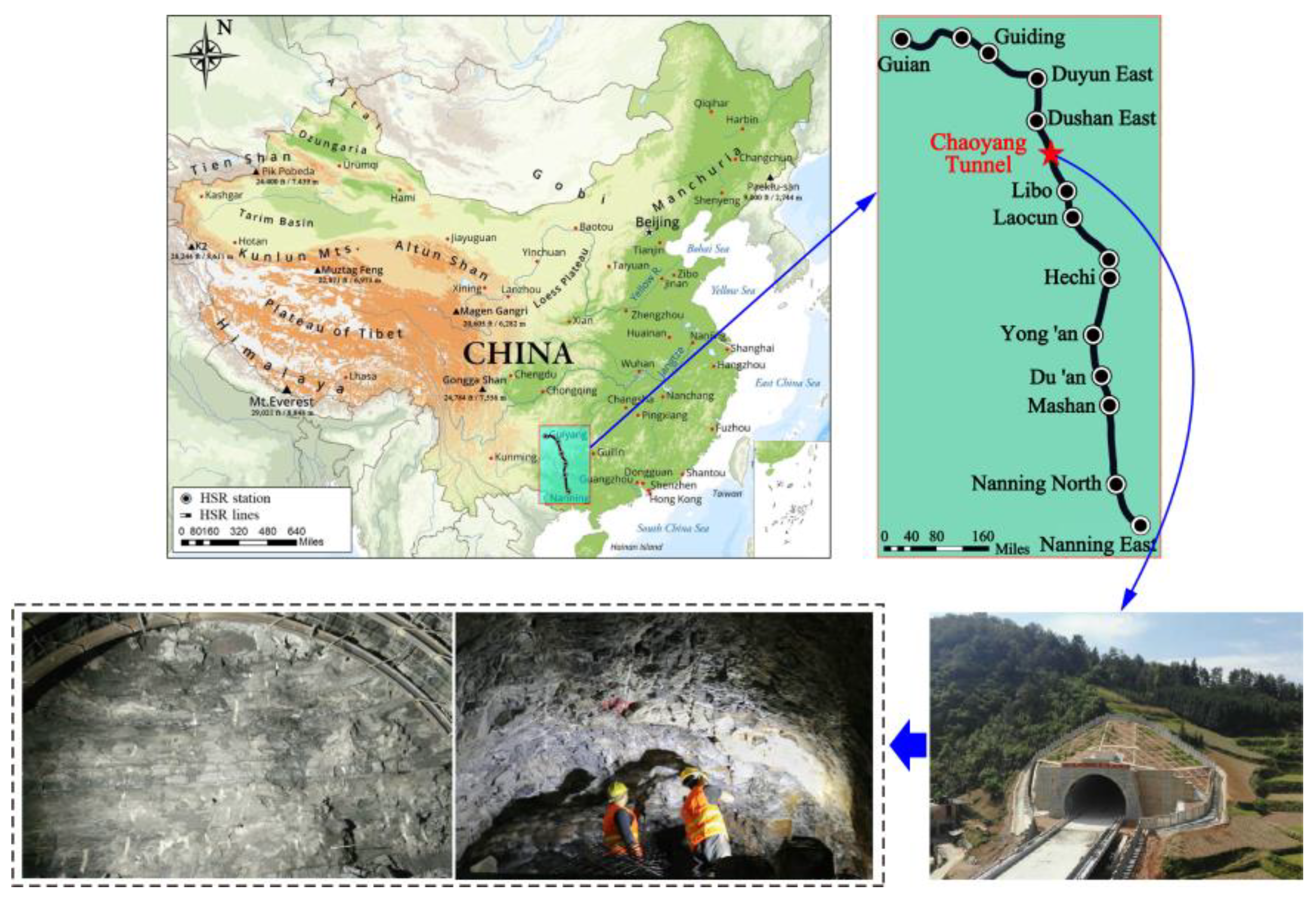
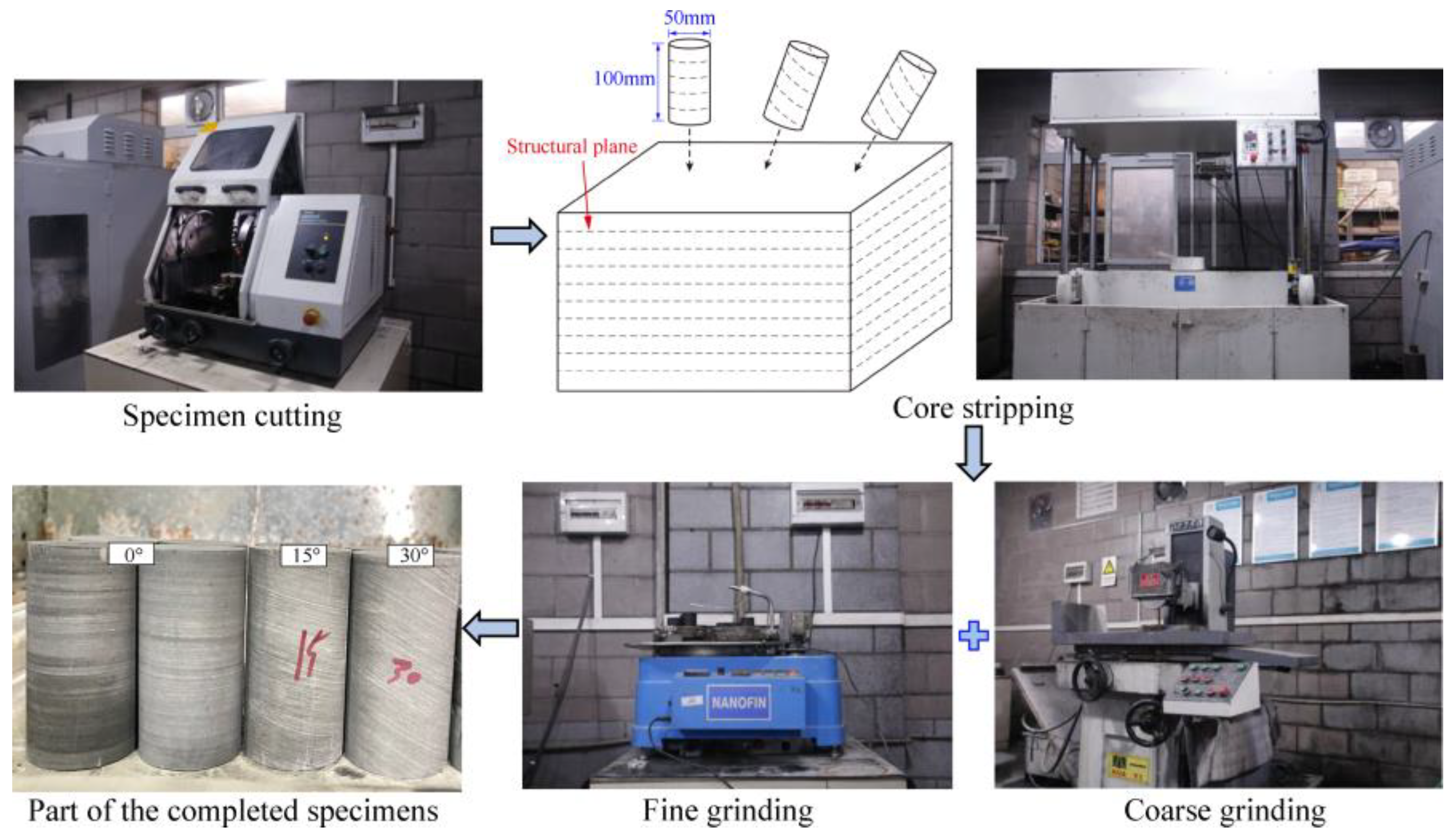
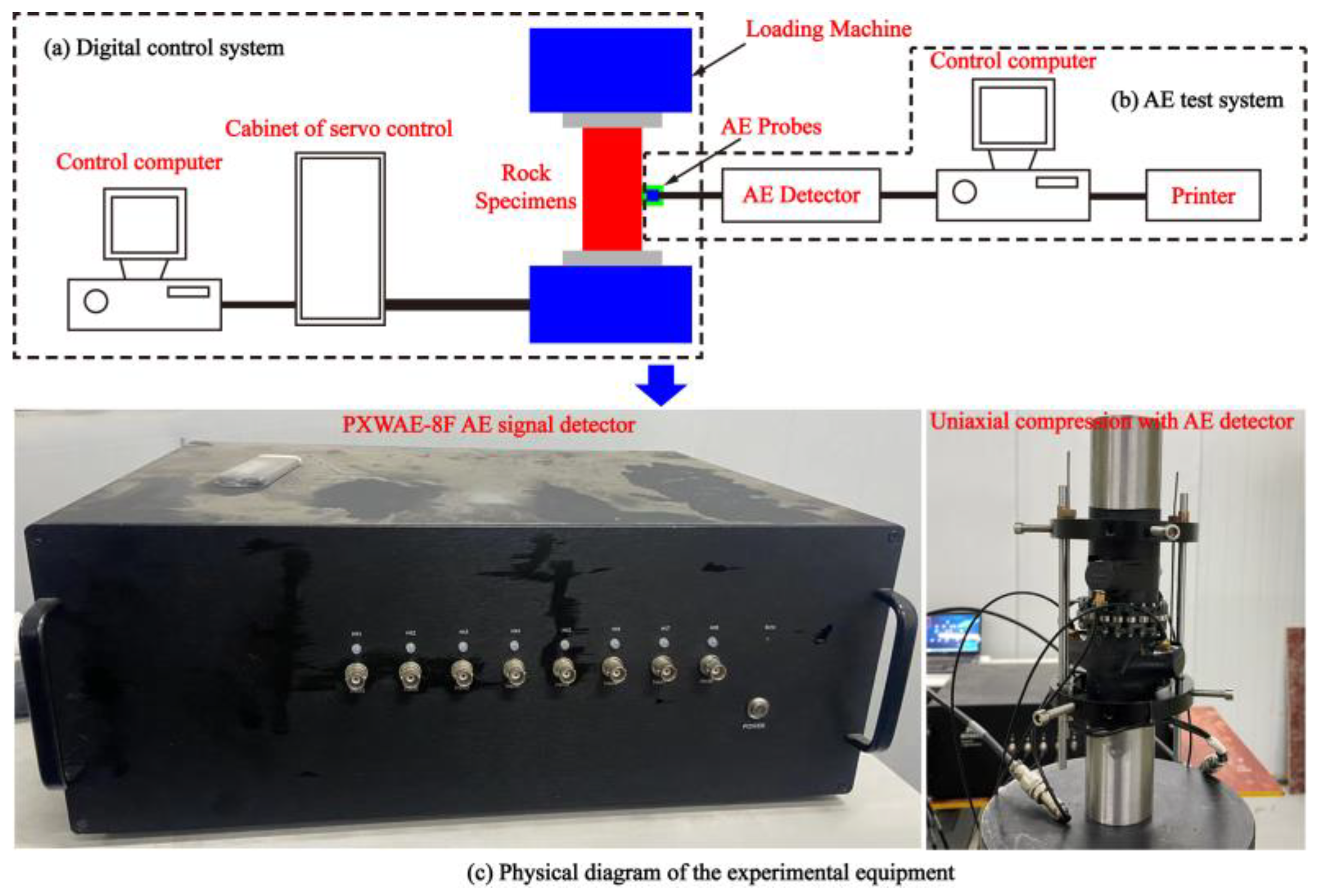
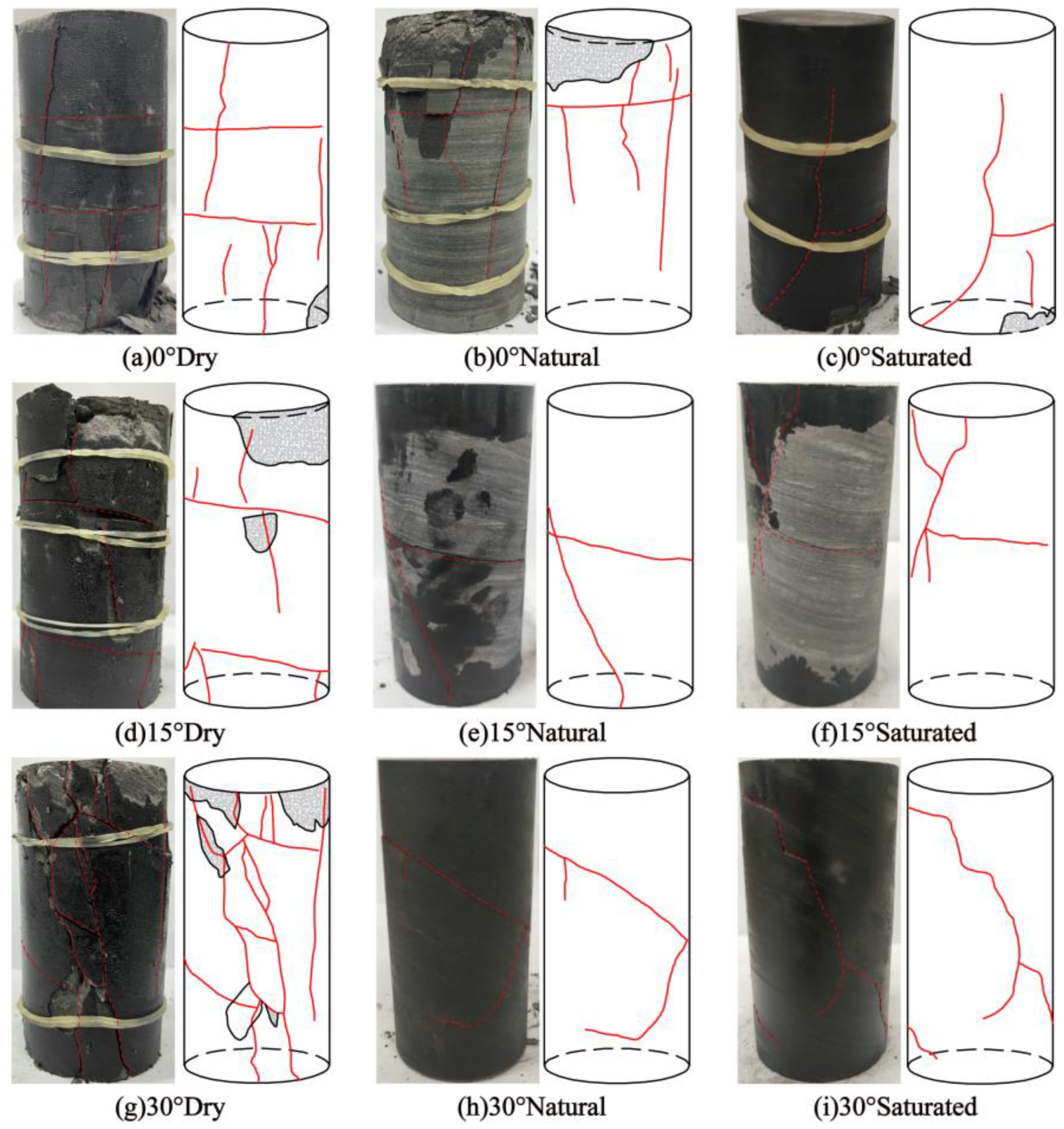

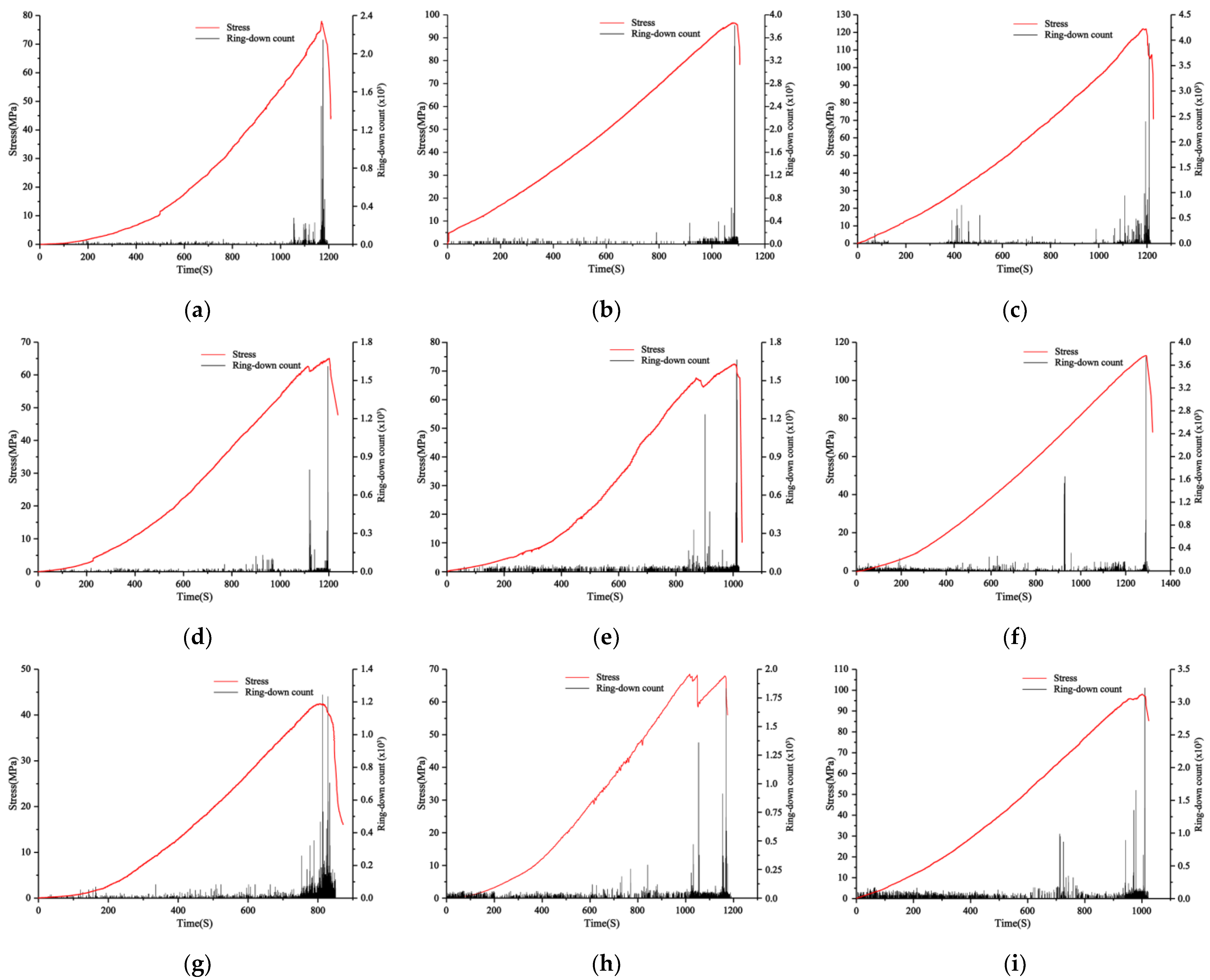
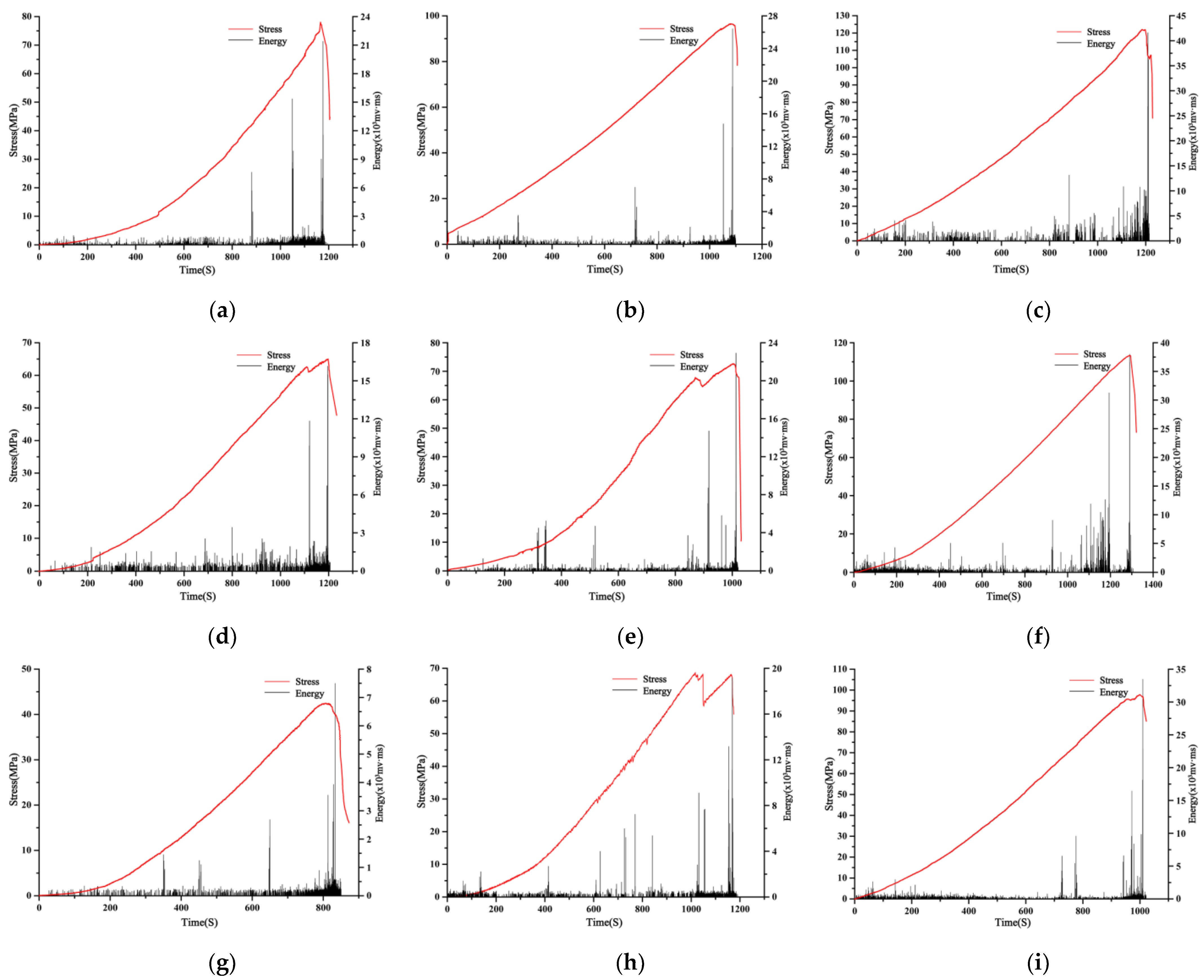


| Working Condition | Compression Strength (MPa) | Proportion of Tension Failure (%) | Proportion of Shear Failure (%) | Main Failure Mode |
|---|---|---|---|---|
| 0° Saturated | 78.0 | 68.2 | 31.8 | Tensile failure |
| 0° Natural | 96.5 | 65.8 | 34.2 | Tensile failure |
| 0° Dry | 121.9 | 60.2 | 39.8 | Tensile failure |
| 15° Saturated | 64.9 | 58.7 | 41.3 | Tensile failure |
| 15° Natural | 74.2 | 53.2 | 46.8 | Composite tensile-shear failure |
| 15° Dry | 111.9 | 51.4 | 48.6 | Composite tensile-shear failure |
| 30° Saturated | 42.5 | 50.5 | 49.5 | Composite tensile-shear failure |
| 30° Natural | 68.5 | 47.8 | 52.2 | Composite tensile-shear failure |
| 30° Dry | 98.0 | 44.7 | 55.3 | Composite tensile-shear failure |
Disclaimer/Publisher’s Note: The statements, opinions and data contained in all publications are solely those of the individual author(s) and contributor(s) and not of MDPI and/or the editor(s). MDPI and/or the editor(s) disclaim responsibility for any injury to people or property resulting from any ideas, methods, instructions or products referred to in the content. |
© 2023 by the authors. Licensee MDPI, Basel, Switzerland. This article is an open access article distributed under the terms and conditions of the Creative Commons Attribution (CC BY) license (https://creativecommons.org/licenses/by/4.0/).
Share and Cite
Chen, B.; Zhang, Z.; Lan, Q.; Liu, Z.; Tan, Y. Experiment Study on Damage Properties and Acoustic Emission Characteristics of Layered Shale under Uniaxial Compression. Materials 2023, 16, 4317. https://doi.org/10.3390/ma16124317
Chen B, Zhang Z, Lan Q, Liu Z, Tan Y. Experiment Study on Damage Properties and Acoustic Emission Characteristics of Layered Shale under Uniaxial Compression. Materials. 2023; 16(12):4317. https://doi.org/10.3390/ma16124317
Chicago/Turabian StyleChen, Binke, Zhiqiang Zhang, Qingnan Lan, Zheng Liu, and Yinjun Tan. 2023. "Experiment Study on Damage Properties and Acoustic Emission Characteristics of Layered Shale under Uniaxial Compression" Materials 16, no. 12: 4317. https://doi.org/10.3390/ma16124317






